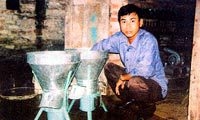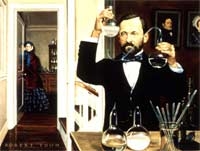According to a study published in the journal Nature on October 23, there is a type of powder that can absorb carbon dioxide more effectively than planting trees.
A typical tree can absorb up to 40 kilograms of carbon dioxide from the atmosphere over the course of a year. Now, scientists at the University of California, Berkeley, report that they can achieve similar results with approximately 200 grams of fine yellow powder.
The study published in Nature highlights that these powder particles contain extremely tiny pores that can trap greenhouse gases. They will then extract the greenhouse gases from the powder and store them somewhere to prevent them from contributing to global warming. In tests, the material maintained its performance after 100 such cycles.
Omar Yaghi, a network chemist at the University of California, Berkeley, and the lead author of the study said, “Based on the stability and activity of the current material, we believe it will function for thousands of cycles.”

Molecular structure of COF-999.
Known as COF-999, this powder can be deployed in large-scale direct air capture facilities that are beginning to operate to reduce carbon levels in the atmosphere.
Scientists state that maintaining carbon dioxide concentrations in the atmosphere below 450 parts per million (ppm) is essential to limit global warming to 2 degrees Celsius compared to pre-industrial levels and to prevent some of the most catastrophic consequences of climate change. Measurements taken at the Mauna Loa Observatory in Hawaii show that CO2 levels are currently around 423 ppm.
Yaghi, who is also the chief scientist at the Institute for Digital Materials at Berkeley, said, “You have to take CO2 from the air—there is no other way. Even if we stop emitting CO2, we still need to remove it from the air. We have no other choice.”
Klaus Lackner, founding director of the Center for Carbon Management at Arizona State University, agrees that direct air capture will become an important tool for sequestering carbon and cooling the planet, once significant barriers are overcome. He noted that advances in this new research could be beneficial.
Lackner, who was not involved in the study, stated, “We are opening the door to a range of new approaches.”
According to the research team leader Zihui Zhou, a materials chemist pursuing a Ph.D. at Berkeley, when observed under an electron microscope, the powder particles resemble small basketballs with billions of pores.
The structures are held together by some of the strongest chemical bonds in nature, including those that transform carbon atoms into diamonds. Compounds known as amines are attached between the bonds.
As air flows through the structures, most of its components pass through without disturbance. However, the amines, which are basic in nature, attract the acidic carbon dioxide molecules.
Those CO2 molecules remain in place until scientists release them using heat. They can then capture them again and pump them deep underground to prevent them from escaping into the atmosphere.
After removing carbon dioxide from the powder, the entire process can start again. To test the carbon-cleaning ability of COF-999, researchers packed the powder into a stainless steel tube the size of a drinking straw and exposed it to outdoor air for 20 consecutive days.
Zhou indicated that when entering the tube, Berkeley air contained CO2 at concentrations ranging from 410 ppm to 517 ppm. When it exited the other side, the scientists could not detect any carbon dioxide.
According to the creators of COF-999, this powder has several advantages over other materials. Its porous structure increases the surface area for contact, meaning there are more places to hold CO2 molecules. Consequently, COF-999 captures carbon dioxide at a rate “at least 10 times faster” than other materials used for direct air capture.
Another advantage is that COF-999 will release CO2 when heated to about 60 degrees Celsius. Zhou mentioned that comparable materials must be heated to 120 degrees Celsius to extract carbon, which is energy-intensive, and consuming energy can lead to more greenhouse gas emissions.
This powder is also more durable. Zhou noted that the team tested a newer version that could operate for 300 cycles before the experiment concluded.
Lackner remarked that this is a positive sign. He said, “Achieving 100 cycles with no degradation indicates we could perform thousands of cycles. We don’t even know if we could achieve hundreds of thousands of cycles.”
The team members have continued to improve the material, and they are on track to double its capacity in the coming year. Zhou mentioned that implementing it on an industrial scale would require designing a large metal box through which air can pass but not blow away all the powder. These boxes would need to be grouped together in numbers similar to those in a modern chemical or oil refinery.
Yaghi stated that a version of COF-999 could be ready for direct air capture plants within two years. He could not estimate the cost of large-scale production but revealed that it does not require any expensive or exotic materials.
Yaghi has established a company, Atoco, based in Irvine, to commercialize his carbon capture research and other technologies. Atoco has helped fund this new research. Additionally, the University of California, Berkeley, has filed a patent application for COF-999, naming Yaghi and Zhou as inventors.
Lackner mentioned that the entire process of direct air capture must become “ten times cheaper than it is now.” Only then can this technology make a real impact on the hundreds of billions of tons of carbon dioxide that scientists aim to remove from the atmosphere.
A more efficient material for collecting CO2 would be beneficial, but Lackner stated that he spends more time worrying about issues such as how much energy it takes to store carbon underground because that energy consumption also contributes to global warming. He said, “There are thousands of factors that affect this.”





















































